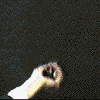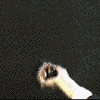A Critique and Appreciation by Rick Appelbaum
This Website, Livingroom.org was created in the spirit of and dedicated to Randy Hostetler. An eclectic, dynamic and exciting composer, performer and artist who left us too soon. Info about Randy, his music and the Living Room Concert Series he produced are on this site.
Last Tuesday, 13th of January in NYC, MATA (Music at the Anthology), a new music series produced by composer/performers Lisa Bielawa, and Eleanor Sandresky (and executive producer Phil Glass) – had a concert.
On the program was a piece by Randy Hostetler, P[l]aces, an Electric Groove for 11 Instrumentalists and Lamp Shades. When Randy started this piece in ’88 I remember talking about it with him, and I remember seeing the score. I knew that the piece was complicated in that it layered many different styles of music in different rhythms and meters together. This was a fertile period for Randy when he did some other seminal works like “Happily Ever After” and “8”. In this period Randy was employing his interest in collage and multi-layered composition. He was a master at this.
The challenge of putting together a performance of P[l]aces was great. For many reasons. One, the piece was never entirely finished. Two, much of the vital information only existed in Randy’s mind. Three, there was no defintive score.
I salute Lisa Bielawa for her Herculean and dedicated efforts in researching the piece, finding the parts and old notes and files on old computers and piecing it back together in a coherent fashion. It is my understnading that she even spoke to performers who were involved in the only attempted performances of the piece in ’89. Thankfully there was some video footage of Randy conducting as well.
The piece was a great success in this NYC performance. It was dynamic and filled with energy. The players seemed to keep up and be inspired. The music itself is made of a collage of musics that inspired Randy, including Latin styles and old Jazz styles. A timekeeper taps a 3 against 4 rhythm throughout which changes in interpretation depending on what else is happening against it. This was the influence of West African music that Randy had been studying and performing in that time period in which the bell pattern is the foundation though many other polyrhythms are layered on top.
The music was vibrant and exciting with a constant momentum forwards. Good shifts in density and balance kept it fresh for the audience and the strong rhythmic and polyrhythmic underpinnings gave it energy and got peoples bodies to respond. This piece though is more than a sum of or pastiche of music of other styles, it was distinctly Randy with sublime moments and the final unmistakeable trademark – wit. I glanced several times around the audience to see folks grinning, a sure and final sign that the piece was close enough to his intentions and good art/music. Like much good music, elements moved from foreground to middleground to backgound fluidly. The visual element of turning on and off the Lamp Shades enhanced the piece’s impact. At one point, the bass players shade dislodged a bit cockeyed and the bulb was exposed. I know that this would have been Randy’s favorite moment as like Cage, he loved the accidents, and felt it was as if he was there with us, winking at me, as if to say good job everybody. Well done.
There were also political implications to aspects of this piece. This piece was concieved when legislation was being created to deal with the whole world of “sampled music”, and Randy had his own views on appropriating art-ifacts that are available in various media in the culture. At one point there is an excerpt of Chuck D, rapper from Public Enemy talking about this. Though at points, this composition is dense and almost cacohphonous, it is not random. Randy was scrupulous and detailed and precise. Rhythms are meant to interact. He sampled the sample at the precise limit of the law. I hope that Lisa or someone else will post her program notes and reflections on this piece on this website in the future – as I am sure she can lend more insight.
I know that audio and video recordings were done, and I hope to see this material get greater exposure both on this website as well as perhaps some New Music/Art CD_ROM project.
Friends, family and colleagues converged on Manhattan from SF, Texas, Chicago, Connecticut, DC, NY and all over. There was a lively reception with good food and drink, and the original score and some parts and notes were hung in the lobby for people to examine.
Randy’s loss to his family and friends is inmeasurable, but thankfully there is a record with his music, drawings, video, and other media to preserve — and allow us to not only remember him, but to still be moved and excited with his art.
Bravo!
Richard (Rico) A. Appelbaum, Jan. 20, 1998 – SF


